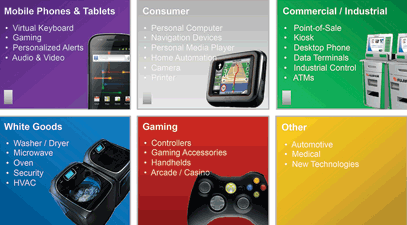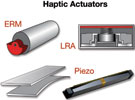
Anyone who has typed a message into a smartphone or touchpad and not just heard but felt the click of a key on the smooth screen has experienced haptics, the use of electronic technology to simulate the sensation of touch.
While haptic experiences are a recent addition to consumer products with touchscreens, the technology has been around for some time in video games and training simulation systems. In these systems, joysticks, sliding knobs, pedals, steering wheels and other electromechanical controls have electronic effects supplied to simulate the way a real system feels. Now, similar effects are at the fingertips of a much larger group of people every time they enter a phone number or send an email.
Haptic applications like these may seem to be just another electronic curiosity, but in fact they represent the leading edge of an important change in how we deal with machines. Touchpads and other human interfaces featuring haptics are in development for industrial systems, robotics, automobiles, home appliances, point-of-sale and order entry systems, new forms of training simulation and remote equipment operation, among other application areas (Figure 1).

In fact, just about everywhere that people have to touch a screen or operate some other kind of electronic control, haptics have a role to play. These simulated tactile experiences are not only important for our pleasure and ease of use, they can also add new functions, provide useful new information, enhance control, improve safety of operation, and enable new forms of product differentiation.
The underlying semiconductor technology that enables haptics is available, inexpensive and easy to design with. Texas Instruments (TI) has applied its design and integration expertise to create differentiated haptic solutions with wide-ranging possibilities in a number of emerging applications.
As system designers and manufacturers discover how adding haptic features can benefit their products, they will use integrated circuit (IC) devices to create a variety of applications with simulated tactile feedback to make our interaction with a variety of equipment seem more natural.
Bringing back the physical sense of control
As electronic control systems replace older mechanical ones, we lose the physical feedback of operation. That is, we lose the sensation that comes from touching, holding, sliding, turning, gripping, pushing, pulling and otherwise manipulating the system and feeling it respond. Haptic features simulate this feedback, so that a completely electronic human interface responds as if it were a familiar mechanical or electromechanical control.
For example, a video gamer knows how it feels to turn a car with a steering wheel and mechanical linkage, but a steering wheel on a plastic panel feels nothing like that unless haptics in the system simulate the drag of turning. Similarly, touchscreens, valuable as they are, don’t feel anything like mechanical keypads unless haptics provide some sort of clicking or bumping sensation for the finger when a key is pressed (with perhaps a ‘click’ sound to reinforce the action through another sense modality). Haptics bring back something important that we’ve lost, and in doing so they can make products easier to use and more enjoyable.
Not surprisingly, haptic feedback has been extensively incorporated in simulated training for systems where operation is complex and needs to be executed flawlessly. For example, aircraft pilots train extensively in simulated cockpits before they fly a different type of plane.
As important as it is for the pilots to learn the procedures and ‘see’ out the cockpit windows with video simulation, they also need to learn how the plane feels in response to the controls as it takes off, climbs, flies through smooth and rough weather, descends and lands. Haptics help provide these sensations, so that when the time comes to sit in a real cockpit, the pilot not only knows how to use the controls, but also how the plane and controls feel in operation.
Haptic feedback is also used in training for surgery, where it adds the sense of touch to three-dimensional graphic visualisation of human tissue. Surgeons get a sense of how the tissue feels, and they learn to manipulate their instruments in tight spaces where the body pushes back against their hands and instruments. For laparascopic surgeries and other forms of endoscopy, simulated training with haptic feedback is crucial for learning how to use the miniscule instruments involved.
In some experimental cases, expert surgeons are using simulation tools with haptics – aided by live video, monitoring instrumentation and a support staff with the patient – to perform real surgeries at distant sites.
Putting haptics to work in new ways
Simulated training represents the high end of haptic application, where system cost is less critical than achieving something difficult but indispensable. In contrast, with mass market items such as smartphones, tablets and video games, doing something innovative matters but must have minimal effect on the shelf price.
Today, the frontier of haptic application is in areas between these extremes, where some increase in price will afford tactile features that can extend the product’s function, make it easier to use, increase safety or otherwise differentiate it. Such applications are found in robots and other equipment for transportation, building automation, home appliances, commercial systems, office equipment, and a variety of other products where users can benefit from haptic interaction with machines.
Among the most promising applications for haptic innovation is keypad input, where flat electronic keys have been displacing mechanical keys for years, with an increasing appearance of touchpads and touchscreens recently for more variable tasks.
For example, consider a worker on an assembly line, who may need to punch data into a flat-screen panel while keeping an eye on different gauges, instruments, products moving on the line, and many other functions. The worker has to stop watching everything else in order to look at the panel and push the right button or series of buttons, creating possibilities for missing some event or simply making mistakes from visual overload. It would help matters if the panel offered some non-visual feedback to help the worker register that the data entry is correct.
Adding sounds for each button may not help much because factories are often noisy, but bumping sensations can report by touch whether the data is being entered. The result of one detail – adding haptic ‘bumps’ to the human interface – can enable a better functioning assembly line that is not only more productive, but also safer.
If the previous example seems remote from everyday experience, consider how useful it would be to sense tactile feedback from the buttons on the smooth keypad of a microwave oven the next time you need to use it in the dark, or to confirm through fingertip feedback that you’ve found the right controls on the complicated dashboard of a rental car.
Haptic features help provide these experiences and others, such as:
• Giving a distracted waiter a specific tactile response for selecting a menu item on a touchpad.
• Making a computer touchpad feel more as if it is tracking over a solid surface.
• Providing a variety of new directional movement sensations for pointing devices such as computer mice and TV remote controls.
• Giving control sensations in the steering wheel and driver’s seat of a car.
• Adding subsonic vibration to headphones to enhance the physical sensation of deep bass sounds.
Seemingly simple haptic sensations can have profoundly significant applications: the same kind of physical resistance that a video gamer feels in moving a joystick can also help the remote operator of a machine used in hazardous rescue, exploration, mining, manufacturing and other environments where human beings need to go but can’t do so safely.
In the future, applying haptics in new areas will, in turn, create demand for even more sophisticated forms of tactile experience. For instance, one day when you select a garment online, you may be able to feel the difference between silk, cotton, wool and synthetic materials through your touchpad. Although the technology isn’t in place yet for creating such sophisticated tactile experiences economically, new areas of application for haptics are creating a market environment that will favour its development.
Technology for haptics
While the psychology of tactile simulation and its interpretation can be complex, creating haptic effects themselves is relatively straightforward. Manipulable controls, such as joysticks, convey haptic information through shaking and bumping, as well as through resistance that can increase, decrease and even stop movement altogether.
On flat surfaces such as touchscreens, one way to create effects is through whole-body vibration, where the entire surface shakes, as with an alarm or ring vibration on a smartphone. By contrast, local vibrations slightly, briefly deform the surface where it is touched, creating a bump or dip under the fingertip.
Some systems are now appearing that can move the deformation along to lead or follow the fingertip. The brain interprets the resulting sensation in a way that corresponds to feeling a button pressed, a knob sliding, a different surface texture, and other expectation.
Different application requirements, including size and vibrating characteristics, determine the type of actuator that the system uses to create its haptic effects. For instance, whole-body effects can be created by an electric rotating mass (ERM), which is a small rotating motor with an off-centre mass that spins at various speeds to create vibrating effects. Button or key effects in fixed positions may be implemented using an array of linear resonant actuators (LRAs), which are spring-mass systems that vibrate up and down in response to changes in a magnetic field.

More complicated local vibrations can be achieved with actuators that employ the piezo effect (Figure 2) – the tendency for certain materials to change shape when a voltage is applied. Piezo actuators enable precision actuation for high-definition haptics and are being increasingly used for novel effects in touchscreens, including the sensation of friction or even texture recreation.
Since the piezo effect is two-way, with deformation creating a voltage as well as voltages deforming the materials, piezo devices are capable of serving for sensing as well as actuating, so that the same device handles both pressure input and tactile output. The devices are very thin compared with other actuators, giving them an advantage in low-profile systems such as keyboards in portable computing.
The second half of this article, which delves into the technical details of the components used for haptic feedback, will be published in the next issue of Dataweek.
For more information contact Erich Nast, Avnet South Africa, +27 (0)11 319 8600, erich.nast@avnet.eu, www.avnet.co.za
© Technews Publishing (Pty) Ltd | All Rights Reserved